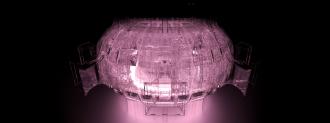For the first time in more than 20 years, scientists are testing the ability of an extremely rare form of hydrogen to power a nuclear fusion reactor.
If they can perfect their nuclear fuel through these experiments, it’ll be used to power the world’s largest nuclear fusion reactor — bringing the dream of near-limitless clean energy one step closer to reality.
What Is Nuclear Fusion?
Nuclear fusion occurs when two atoms combine into one. This releases an enormous amount of energy — enough to power the sun and other stars.
Fusion only happens when atoms are under tremendous heat and pressure, and despite decades of trying, scientists have yet to figure out how to use fusion to stably generate energy on Earth.
If they could, though, fusion power would have several advantages over our current sources of energy.
Unlike the burning of fossil fuels, the process doesn’t produce any greenhouse gases, and its main power source — hydrogen — is abundant on Earth.
Fusion is safer than nuclear fission and doesn’t generate long-lived radioactive waste. It’s also more reliable than renewables, such as wind or solar, which are dependent on environmental factors — at least, it would be, if we could get it to work.
The Tokamak
The most promising device scientists have come up with for harnessing fusion energy is a hollow, donut-shaped machine called a tokamak.
Inside a tokamak, gaseous hydrogen fuel turns into a plasma under the influence of extreme heat and pressure.
Magnets on the outside of the hollow area control the movement of this plasma, and as atoms within it undergo fusion, the interior walls absorb their energy.
We know this type of nuclear fusion reactor works, but the problem is the magnets require a crazy amount of energy. We still haven’t been able to get one to produce more energy than we put into it — the best power output to power input ratio anyone has achieved with a tokamak is 0.67:1.
It’s very exciting to put into practice what we’ve been preparing all these years.
Joelle Mailloux
A ratio of 1:1 would be breaking even, and we need something even higher (1.01:1, for example) to actually get energy out of a fusion reactor.
The record high ratio was achieved in 1997 at the Joint European Torus (JET) tokamak, and the fuel used for it was a 50/50 mix of two hydrogen isotopes: deuterium (hydrogen-2) and tritium (hydrogen-3).
Since then, no one has experimented with any significant amounts of tritium in a tokamak, as it’s difficult to work with. Unlike deuterium, which is stable and abundant, tritium is radioactive and rare — there’s less than 45 pounds of it on Earth.
Now, JET researchers are going to give tritium another go, in preparation for the upcoming launch of the world’s largest fusion reactor: ITER.
The World’s Largest Fusion Reactor
ITER is a collaboration between the E.U., the U.S., and five other nations. It’s been in the works since the 1980s, and after many delays, construction on the $25 billion fusion reactor finally began in 2020.
ITER is expected to be ready for its first experiments in 2025, and the goal is to have it running at full power by 2035.
JET is the closest tokamak to ITER in existence, so scientists are testing different ratios of deuterium and tritium in it now to determine the ideal fuel for ITER once it’s ready.
They spent two years retrofitting the fusion reactor to take the beating delivered by repeated tests of the radioactive tritium, and once they begin their experiments, it won’t be safe for humans to enter the inner part of the JET facility for 18 months.
The plan is to run up to 14 experiments a day with a tritium-containing fuel. Each mix will have slightly different parameters, and the tritium used during the experiments will be recycled after each one.
If the fuel tests go as hoped, the JET researchers hope to have all the data they need to transition to experiments with ITER by the time construction wraps up.
“What we are after is physics information that we can use to validate our understanding, and then we can apply that to preparing the future machine,” Joelle Mailloux, co-lead of the scientific program at JET, told Nature.
“It’s very exciting now to, at last, get to the point where we can put into practice what we’ve been preparing all these years,” she added. “We’re ready for it.”
We’d love to hear from you! If you have a comment about this article or if you have a tip for a future Freethink story, please email us at [email protected].






